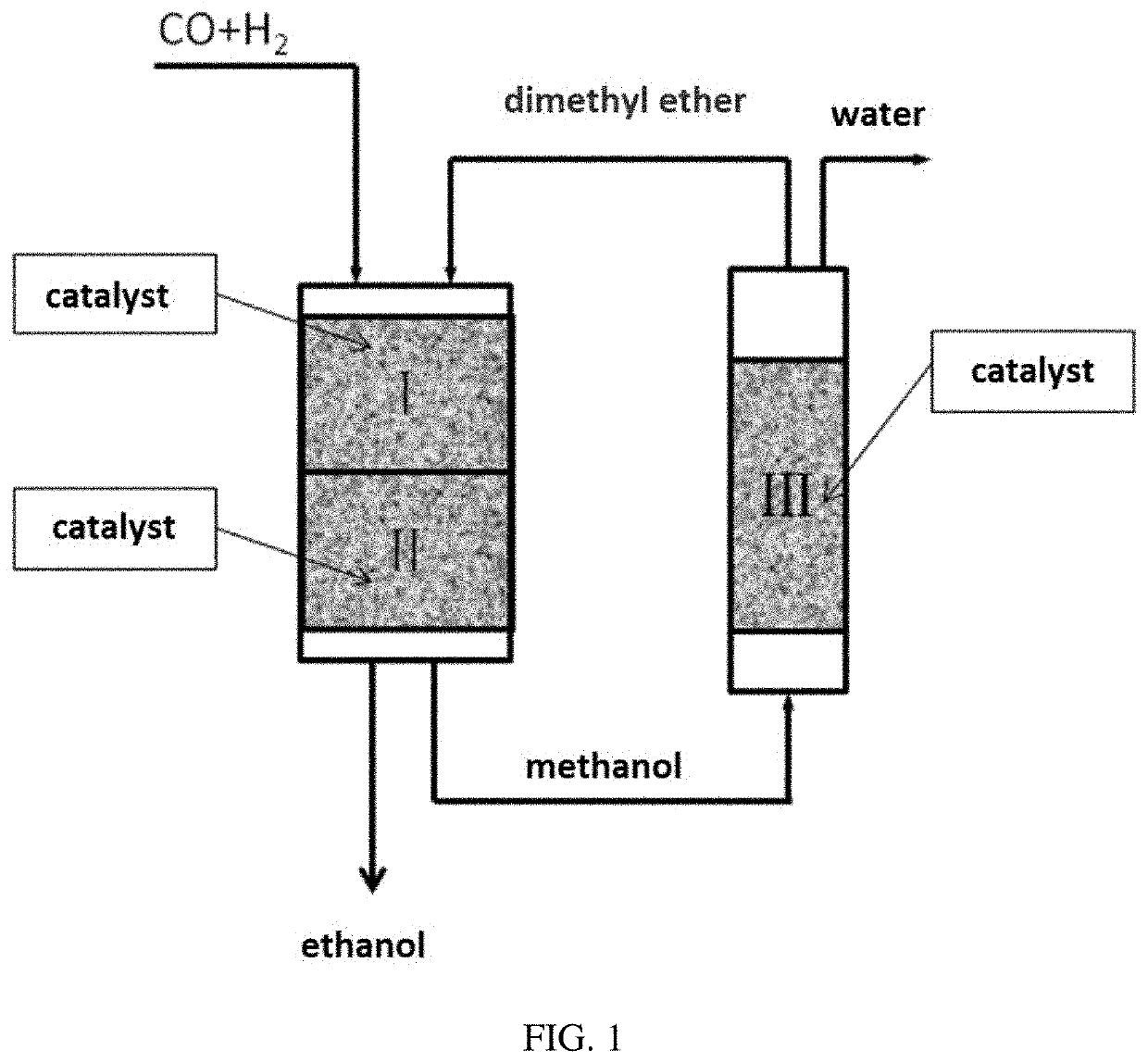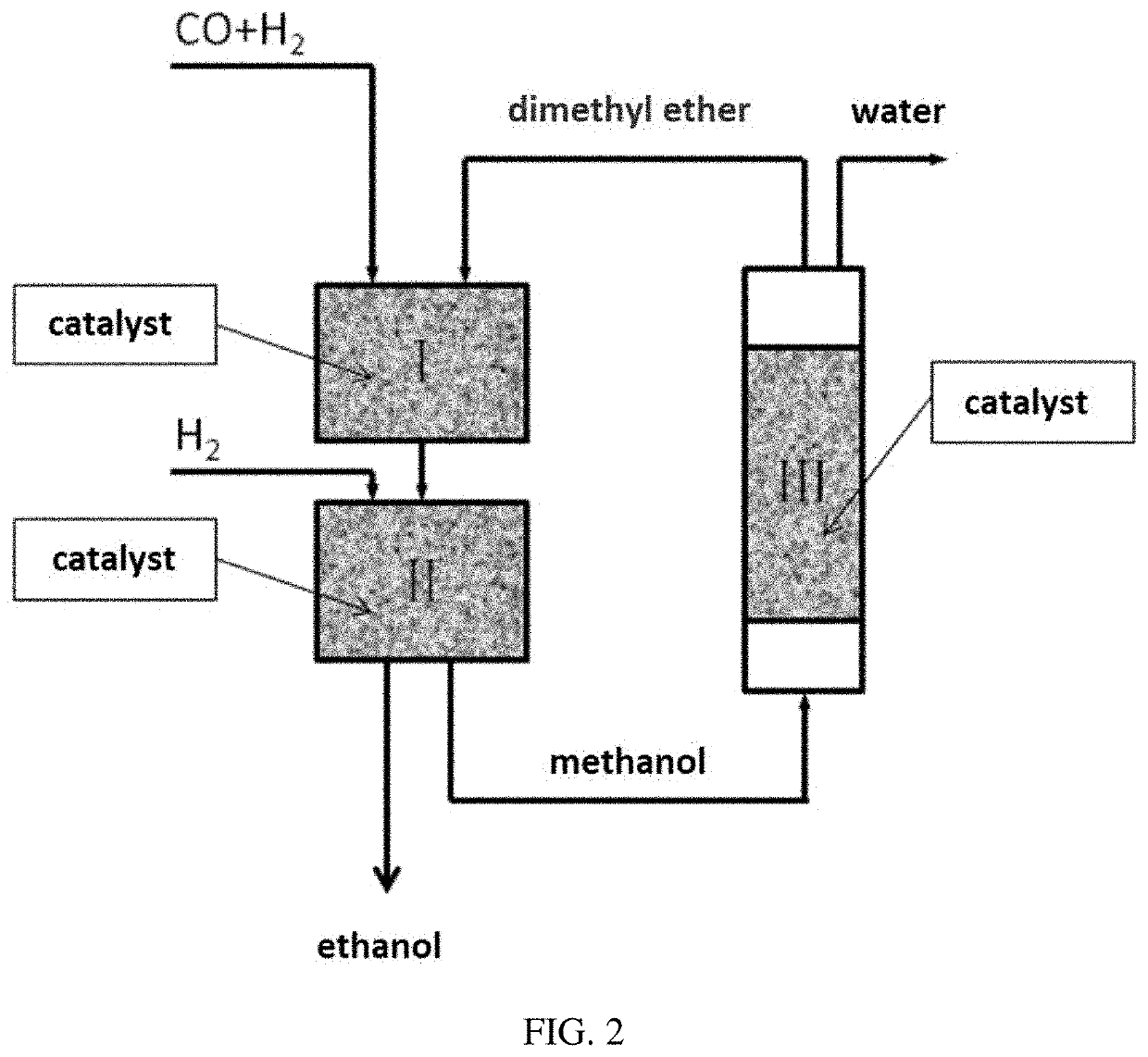Method for directly producing ethanol from syngas
a technology of syngas and ethanol, which is applied in the field of converting syngas into ethanol, can solve the problems of difficult large-scale development, limited biosynthetic fuel ethanol, and operating costs, and achieve the effects of reducing equipment investment costs, reducing energy consumption, and reducing methanol synthesis
- Summary
- Abstract
- Description
- Claims
- Application Information
AI Technical Summary
Benefits of technology
Problems solved by technology
Method used
Image
Examples
example 1
[0053]Catalyst 11# was used in the first reaction zone, catalyst B (copper-based catalyst) was used in the second reaction zone, and catalyst C was used in the third reaction zone.
[0054]In the fixed-bed reactor, syngas containing CO and H2 together with dimethyl ether (DME) passed through the first reaction zone and the second reaction zone. The first reaction zone and the second reaction zone were located in the same reactor, wherein the whole of part of dimethyl ether was produced from methanol generated from CO and H2 in the second reaction zone through the dehydration reaction in the third reaction zone. The specific reaction scheme was shown in FIG. 1, wherein the syngas and dimethyl ether as raw materials were allowed to enter the first reaction zone I to contact with the solid acid catalyst 11# in the first reaction zone and react to obtain an effluent containing methyl acetate and / or acetic acid; the effluent from the first reaction zone was allowed to enter the second react...
example 2
[0057]Different catalysts (1-10# and 12-16#, see Table 4) were used in the first reaction zone, catalyst B was used in the second reaction zone, and catalyst C was used in the third reaction zone.
[0058]In the fixed-bed reactor, syngas containing CO and H2 together with dimethyl ether (DME) passed through the first reaction zone and the second reaction zone. The first reaction zone and the second reaction zone were located in the same reactor (the specific reaction process was shown in FIG. 1 and Example 1), wherein dimethyl ether was produced from methanol generated from CO and H2 in the second reaction zone through the dehydration reaction in the third reaction zone. The reaction conditions were as follows: different catalysts (1-10# and 12-16#, see Table 4) and catalyst B were charged into the first reaction zone and the second reaction zone of the reactor from top to bottom, respectively, and 3 g and 7 g were charged respectively. The molar ratio of CO, DME and H2 was 2:1:12. The...
example 3
[0059]Similar to the procedure of Example 1, in the fixed-bed reactor, the reaction temperature was 215° C., and the reaction pressures were 1, 8 and 15 MPa, respectively. The other reaction conditions were the same as in Example 1. The reaction results when the mixed gas containing CO and H2 together with dimethyl ether passed through the first reaction zone and the second reaction zone were shown in Table 5.
TABLE 5Reaction results at different reaction pressuresPercentPercentSelectivitySelectivityconversion ofconversion ofSelectivitySelectivityfor methylfor ethylSelectivityReactiondimethyl ethercarbon monoxidefor methanolfor ethanolacetateacetatefor otherspressure / MPa(%)(%)(%)(%)(%)(%)(%)117.811.2547.8938.974.188.940.02837.522.2645.2354.770.000.000.001545.025.8244.3956.610.000.000.00
PUM
| Property | Measurement | Unit |
|---|---|---|
| volume ratio | aaaaa | aaaaa |
| pressure | aaaaa | aaaaa |
| temperature | aaaaa | aaaaa |
Abstract
Description
Claims
Application Information
 Login to View More
Login to View More - R&D
- Intellectual Property
- Life Sciences
- Materials
- Tech Scout
- Unparalleled Data Quality
- Higher Quality Content
- 60% Fewer Hallucinations
Browse by: Latest US Patents, China's latest patents, Technical Efficacy Thesaurus, Application Domain, Technology Topic, Popular Technical Reports.
© 2025 PatSnap. All rights reserved.Legal|Privacy policy|Modern Slavery Act Transparency Statement|Sitemap|About US| Contact US: help@patsnap.com


